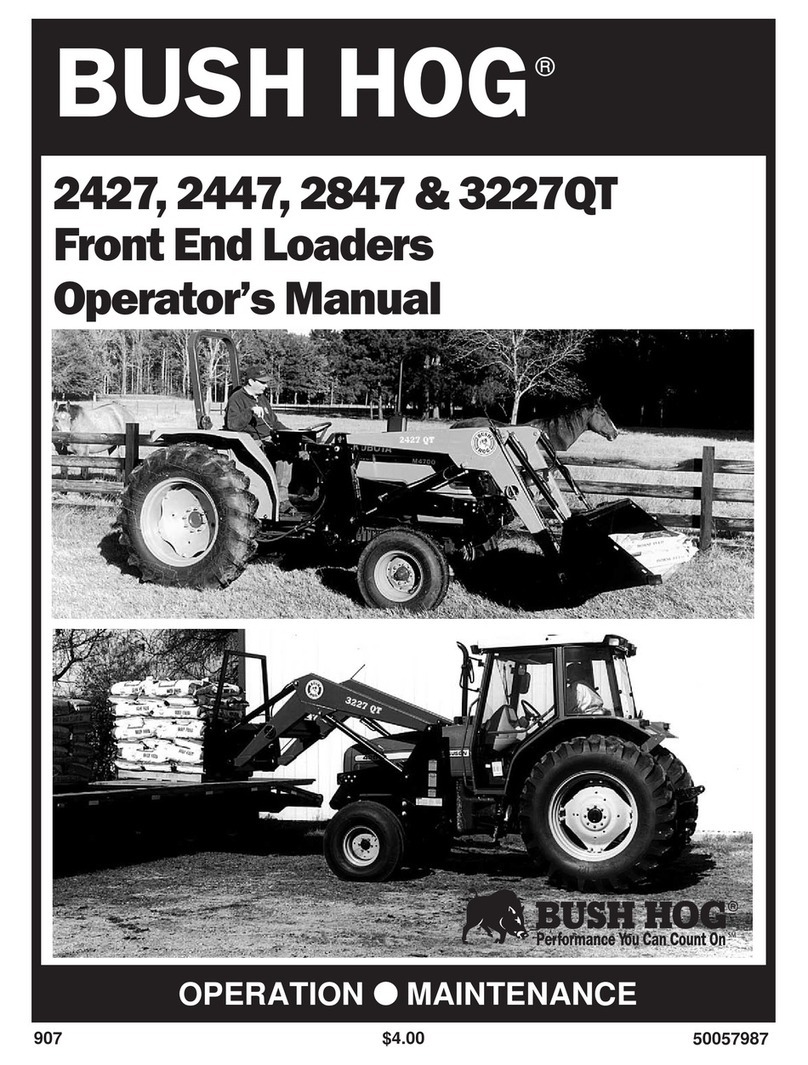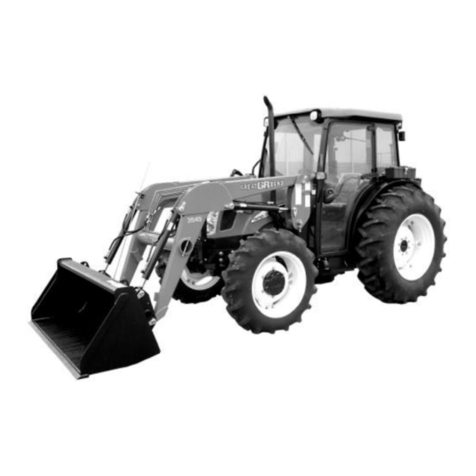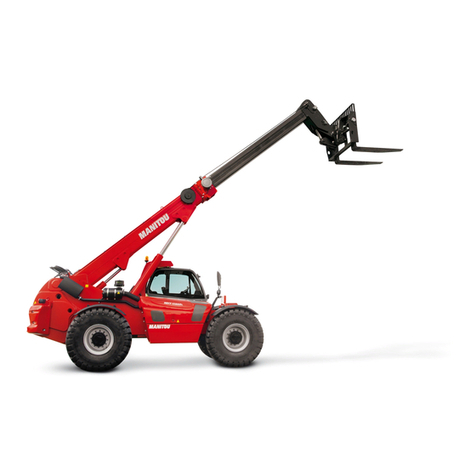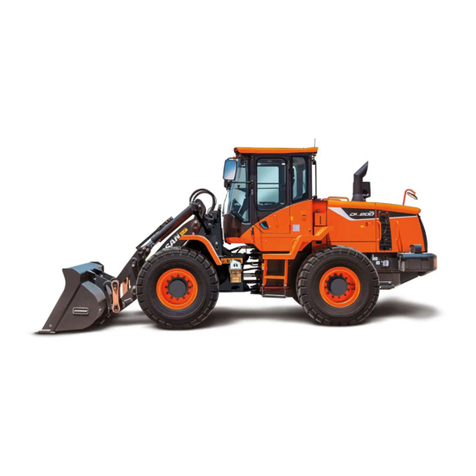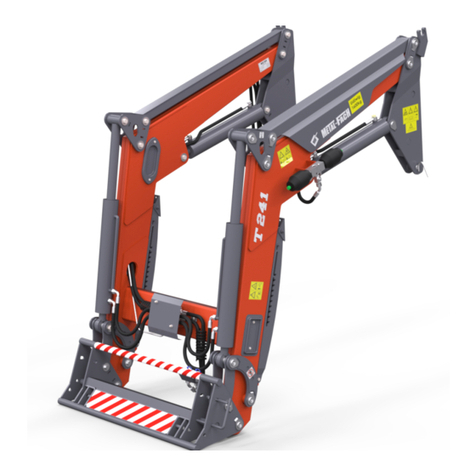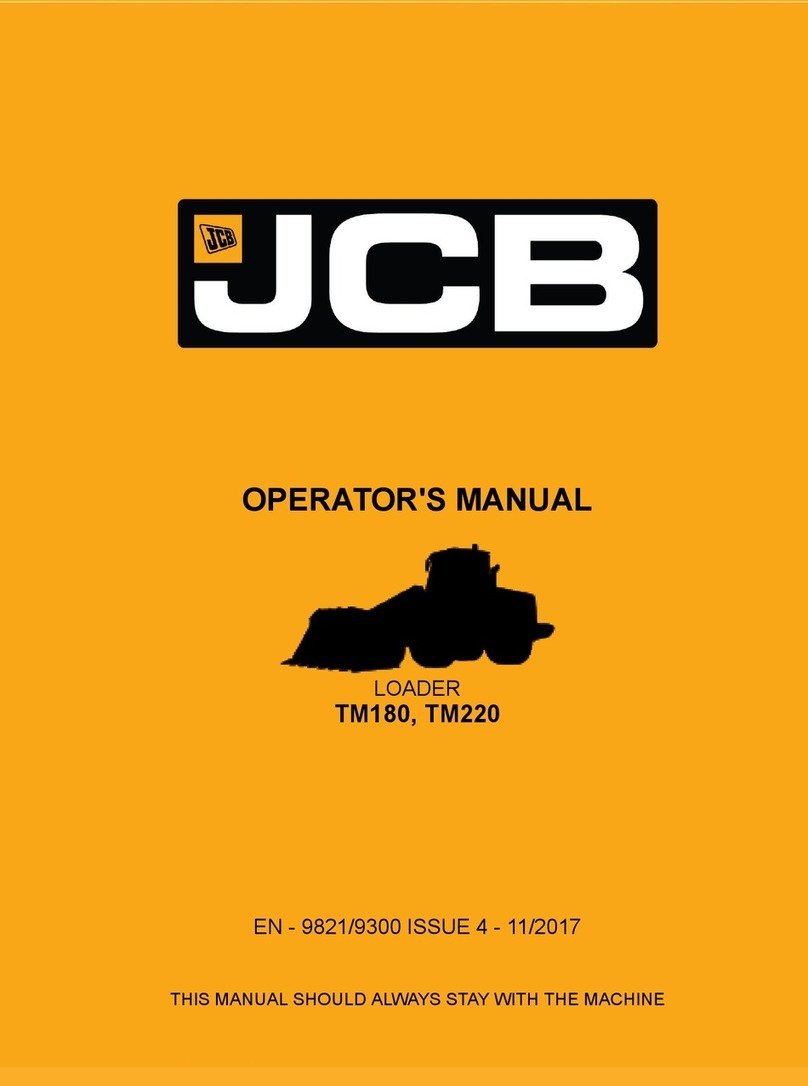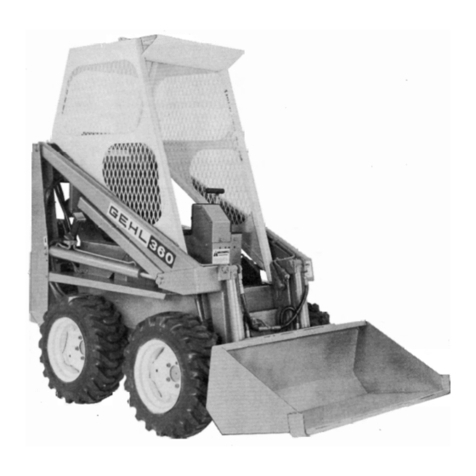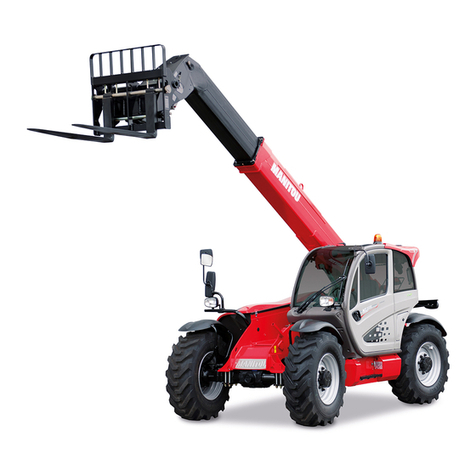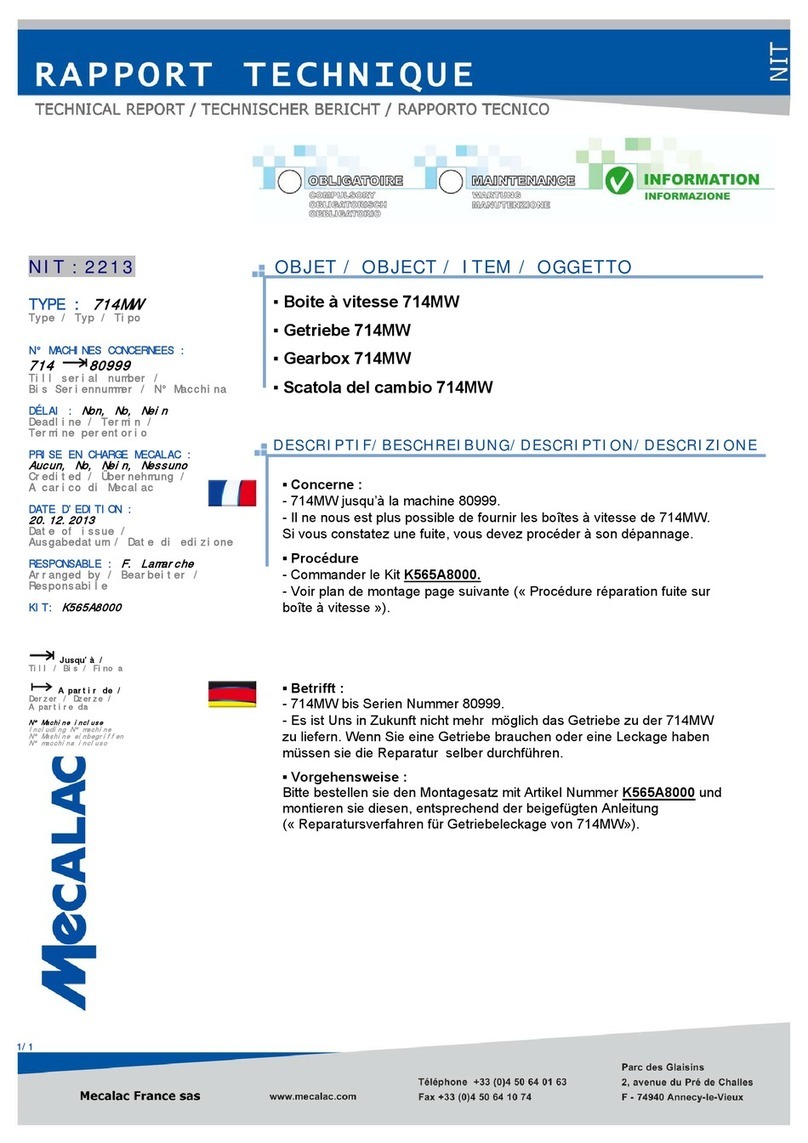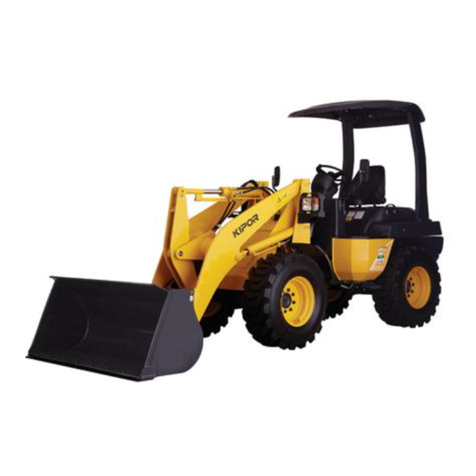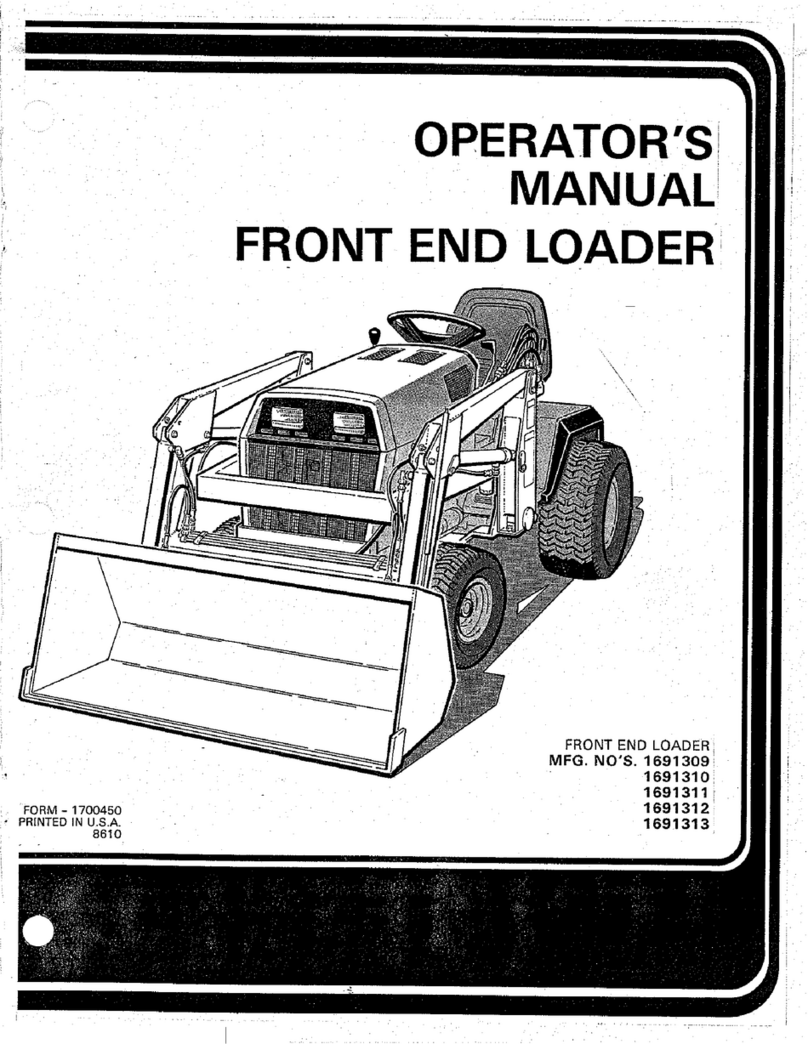ECOVOLVE ED800 User manual

ED800/1000/1500 OWNER’S MANUAL
Battery Hi-Tip Dumpers

1 Introduction
Introductionoverview ......................................................................
2 Safety
Safety guidelines ...........................................................................
3 Overview
Vehicleidenticationplate..................................................................
Operatorsplatformandsafetyrails .........................................................
Controls.....................................................................................
4 Operation
Driving ....................................................................................
Switchingthedumperonando ...........................................................
Operatorsplatformandsafetyrails .........................................................
Forwardtravel ..............................................................................
Reversetravel...............................................................................
Operatingspeed ...........................................................................
Steeringsystem ............................................................................
Brakingsystem .............................................................................
Lights ........................................................................................
Horn .......................................................................................
Operatingthehightipfunction .............................................................
Load ........................................................................................
Emergencystopbutton ....................................................................
Parking .....................................................................................
Batterydischarge ..........................................................................
Charging .................................................................................
Chargingthedumper ......................................................................
ChargingtheQUIQ1000 ....................................................................
ChargingtheIC1200 .......................................................................
CONTENTS
Transportation ..........................................................................
Transportingtheelectricdumper ...........................................................
Cleaning and washing .................................................................
Daily checklist ...........................................................................
5 Servicing
50 Working Hour inspection ..........................................................
Inspectionchecklist ........................................................................
Chassis and frame .........................................................................
Wheels .....................................................................................
Steering and dashboard ...................................................................
Lubrication .................................................................................
Hydraulic system ...........................................................................
Rear drive unit ..............................................................................
Braking system .............................................................................
Electric Charging ..........................................................................
150 Working hour service ............................................................
Servicechecklist ...........................................................................
Reardriveunitoilchange ..................................................................
500 Working hour service ...........................................................
Servicechecklist ...........................................................................
Chassis and frame .........................................................................
Wheels ....................................................................................
Steering and dashboard ...................................................................
Lubrication .................................................................................
Hydraulic system ..........................................................................
Rear drive unit ..............................................................................
Braking system ............................................................................
Battery care ................................................................................
2000 Working hour service ..........................................................
Servicechecklist ...................................................... ....................
Reardriveunitoilchange .............................................. ...................
CONTENTS

6 Technical Data
Technical data sheet EU .................................................................
Technical data sheet US .................................................................
ED800 Parts list
Exploded front view parts list ............................................................
Exploded rear view parts list .............................................................
Steering .................................................................................
Platform and safety rail ..................................................................
Tiller head ...............................................................................
Hydraulic system ........................................................................
Electrical system .........................................................................
Rear drive unit ...........................................................................
ED1000 Parts list
Exploded front view parts list ............................................................
Exploded rear view parts list .............................................................
Steering .................................................................................
Platform and safety rail ..................................................................
Tiller head ...............................................................................
Hydraulic system ........................................................................
Electrical system .........................................................................
Rear drive unit ...........................................................................
ED1500 Parts list .....................................................................
Exploded front view parts list ............................................................
Exploded rear view parts list .............................................................
Steering .................................................................................
Platform and safety rail ..................................................................
Tiller head ...............................................................................
Hydraulic system ........................................................................
Electrical system .........................................................................
Rear drive unit ...........................................................................
CONTENTS
7 Troubleshooting
Troubleshooting charts ............................................................

1. INTRODUCTION
Your electric high tip dumper oers premium economic
eciency, safety and driving
comfort. It is primarily
down to you to maintain these characteristics over
time and take
advantage of the resulting benets.
During manufacture:
• All safety requirements of the relevant EC directives were observed.
• All conformity assessment procedures stipulated in the applicable directives were
carried out.
This is attested by the CE mark shown on the
Identication plate.
The operating instructions contain everything
you need to know commissioning, driving
and
maintenance. Observe the operating instructions
for the electric dumper in question.
Carry out the specied work regularly, at the due
times and using the consumables
envisaged for
this purpose in accordance with the inspection
and maintenance overview.
Servicing work not described here will require
specialist knowledge, measuring devices
and
specialist tools. Contact the service
partner for more information.
Servicing should only be carried out by qualied
personnel approved by the manufacturer
(specialists).
This material is proprietary to Ecovolve, and is
not to be reproduced, used, or disclosed
except
in accordance with written authorisation from
Ecovolve.
Each new user must read the Operator’s Hand Book before operating any Ecovolve
truck for the rst time.
This manual diers from the Operator’s Hand Book which provides comprehensive
instructions of how to operate any dumper manufactured by Ecovolve. The Operator’s
Hand
Book must be kept in the trucks manual holder at all times. A copy of this manual
is
included within this document or can be downloaded at www.ecopvolve.ie.
All maintenance personnel should read and understand the instructions in this service
manual before performing maintenance and/or operational checks on the machine.
All safety notices, warnings and cautions must be understood and followed when
accomplishing repairs on the electric dumper.r
Your high tip electric dumper
1
INTRODUCTION

Warranty and liability
To maximize your warranty, after each periodic
inspection, proof must be submitted to Ecovolve
by way of electronic submission on our website.
This is the only way to prove an eective service
has been completed by a competent and
qualied person as per instructions in this service
manual.
Werrenty submission forms can be downloaded from our website. If you have any questions
regarding your warranty please contact your local distributor. A copy of each periodic inspection
form can also be found at the end of this manual. Please keep and save a detailed record of the
maintenance process. All maintenance procedures must be recorded, otherwise you will limit or
lose your warranty.
Users, especially the truck operators and maintenance personnel, must strictly adhere
to
regional and international safety regulations
including “Guidelines on correct and safe use of
materials handling equipment”. (Overseas
edition). User shall be responsible for any loss
caused
by improper use. Ecovolve Ltd will not be responsible for such loss. If you want to use an
Ecovolve product for purposes that are not mentioned in the user manual, please contact
dealers accredited by Ecovolve Ltd.
Any modication of your machine, in particular
tting of
equipment or conversion of the truck,
is prohibited without the permission of the
manufacturer.
Maintenance
Do not make repairs yourself. Servicing should ony be carried out by competent personnel.
Service technicians are trained professionals and must be competent to carry out the periodic
maintenance required to keep the Ecovolve range operating at peak performance and also to
maximize your warranty.
Inspections and periodic service is vital to the safe operation of the truck. Adhere to a strict
inspection, lubrication and maintenance schedule. Only use original approved spare
replacement parts when carrying out repair work.
Keep the maintenance and service area clean, free from obstacles and anything which may
cause personal injury. Never wear loose objects or jewellery when servicing the truck. Never
attempt to weld or attach ttings to the dumper. This should only be completed by suitable
personnel from Ecovolve. Never attempt to alter the the dumper in any way, especially to drill
any holes on any locations on the machine.
Any modication should only be completed by suitable personnel after consultation and
authorisation from the design team. To comply with warranty conditions, please ensure that
work carried out is recorded in the registration documents. Record and submit all necessary
proof of scheduled service to Ecovolve. Use dedicated work supplies according to checking
and maintenance overviews.
1. INTRODUCTION
This manuals contains, among other things, information on the intended operation of the
dumper and
instructions of how to operate, maintain,
and inspect the truck safely. The
troubleshooting
section of this manual has additional instruction
for safely diagnosing
malfunctions of the electric dumper
to maintain service and performance levels.
Information about this service manual including
the specications, illustrations, weight
information
and technical data are not binding and
correspond to the design at the time of
creation.
Ecovolve reserve the right to make changes without prior notice in the area of
design, conguration, appearance and technology on
account of the ongoing further
development of the products.
Always strictly observe the safety instructions in
this service manual, the operator’s manual and
the legal and trade association regulations at the
usage location.
Despite the utmost care, we cannot rule out deviations from drawings or dimensions,
computing errors, printing errors or incompleteness in this operator’s manual. Therefore, we
make no guarantee for the
correctness and completeness of our statements
in this Owners
Manual.
We guarantee the faultless functionality of our
products within the context of normal operating
conditions.
However, no manual can address every possible
risk. The end-user ultimately must apply sound
judgment whenever using this product. It is up
to you, the operator, to take good care when
working thedumper and use it to its full potential. During the manufacturing process (if axed
with CE mark): Ecovolve adhered to all CE safety requirements. We carried out all
compliance
tests required by law. This is proven
by the CE stamp shown on the identication
plates. The
manual provides you with important information on activating, driving, operating and maintaining
an Ecovolve product.
It is essential you regularly complete the maintenance checklists and make sure it is done on
time. Use the correct tools, products
etc. specied in order to maintain valid warranty service for
your electric dumper.
Please keep and save a complete, detailed record
of the maintenance process. All maintenance
procedures must be recorded; otherwise you
will limit or void your warranty. Users, especially
dumper
operators and maintenance personnel,
must strictly adhere to regional and
international
safety regulations such as “Guidelines on correct
and safe use of material handling
equipment”.
User shall be responsible for any loss caused by improper use. Ecovolve Ltd will not be
responsible for such loss. If you want to use
an Ecovolve product for purposes that are not
mentioned in the user manual, please contact a distributor accredited by Ecovolve Ltd. Any
modication of your dumper, in particular tting of
equipment or conversion of the dumper, is
prohibited
without the permission of the manufacturer.
Owners manual
1. INTRODUCTION

2
SAFETY
1. INTRODUCTION
Replacement parts
The Ecovolve range has been designed to be extremely low maintenance. Therefore
ordering spare parts is much less frequent than of traditional trucks. For questions about the
Truck and orders for spare parts, please contact your local Ecovolve distributor.
If the need to order spare parts arises, please provide the following information in addition to
the part numbers:
�Model number
�Serial number/Year of manufacturing
�Delivery date
Intended use
All Ecovolve electric dumpers have been built according to applicable standards and
regulations. Operationby inexperienced persons or in an unintended manner can result in
hazards that can lead to personal risk and subsequent harm to the operator and persons in
the operating area of the electric dumper. Improper use can damage the machine as well
as property in the vicinity of operation. The electric dumper is designed to work in conned
spaces such as narrow corridors and basements. It sits on a unique shaped chassis which
allows it to turn on its own axis. It is therefore far more maneuverable than a conventional
dump truck.
The Ecovolve Range are intended to transport
and empty materials within the specied
load capacity in normal operating conditions. It is the operators responsibility to use sound
judgment to assess whether a ground material
is compatible with use of the Truck. If in
doubt
contact your nearest distributor. Unintended use
can endanger the lives of operating
personnel
or other persons and cause injuries or extensive damage to the truck.
The rules for the normal and proper use of industrial trucks must be followed under all
circumstances by the responsible persons, in
particular by the operators and service personnel.
Failure to read and understand the entire manual before using or servicing the product
constitutes misuse. Always follow the warnings contained within this guide and on the
Truck to avoid incidents and accidents from occurring.

Operating Instructions
All operators must read and understand the
operating instructions before operating the truck.
A
copy of the Operators Manual should be kept in
the manual holder on the Truck at all times. A
copy
of this manual can be found in this document – Section 2. Before carrying out any work,
the operator should nd a remote site to become
familiar with the controls and machine
response.
The truck shall be in serviceable condition before
attempting to use it as described in
the operating
instructions. If the truck is determined not to be in
serviceable condition, notify the
site or machine
supervisor to have it repaired before use.
Damage and Defects
�Damages and other defects to the truck must be reported to the Supervisor immediately.
Trucks which are not safe to operate may not be used until they have been properly
repaired.
�Safety installations and switches may not be removed or rendered unusable.
�Specied settings may only be changed with the approval of the manufacturer.
Danger Area
�People must not stand in the danger area of an industrial truck. Danger areas are those areas
in which persons are in danger as a result of the movements of machines, their operating
equipment, their load carrying devices (e.g. their attachments) or the loaded goods. This also
includes the area which can be reached by falling goods or lowering or falling operating
equipment and devices.
Driving Conditions
�Use lights in dark and dim areas. Always ensure that there are no pedestrians in the trucks
rear swing area before turning.
�Under all travel conditions, operate the truck at a speed that will permit it to be brought to a
stop in a safe manner.
�It is essential to keep your truck under control at all times.
Load
�Do not exceed the capacity of the dumper. The capacity appears on the trucks identication
plate and the safety labels on skip.
�Do not overll the skip to impair the operators vision.
�Always make certain that the load is secured and arranged evenly in the skip.
�Do not allow people to ride on the dumper. Do not raise the skip over people. Never lift or
lower the load when the truck is in motion.
Unstable loads are a hazard to you and to your fellow workers.
2. SAFETY
Safety guidelines
Ecovolve strives to identify foreseeable hazards associated with the use of it’s products.
However,
no manual can address every possible risk. The possibility of other dangers when
using the truck
cannot be entirely excluded. The end-user ultimately must apply sound
judgment whenever using
the electric truck. Improper or careless use might result in serious
personal injuries or death. Below is
an overview of steps, warnings and advice that can be taken
to prevent and minimize the risk of injury.
This list is not exhaustive and awareness to each local
environment and situation must be exercised by the operator.
Failure to read and understand the entire manual before using or servicing the product
constitutes
misuse. Always follow the warnings contained within this guide and on the Truck to
avoid incidents
and accidents from occurring.
Safety Features
Ecovolve has introduced many safety features to
make the Ecovolve range safe and user
friendly. An overview of these are as follows:
�Three operating speeds: Creeper for when the skip is raised (under 1 km), Walking (under
4km), and Full (7km). The Truck automatically selects Creeper mode when the hi tip function
is activated, . It will automatically select the Walking mode when the step
is in the raised position. The operator can manually select the slower speed at any time if
necessary.
�The Truck has two pull-up safety rails for extra stability for the operator. These must be
used when the operator is using the operators platform.
�The Truck is tted with standard features such as a beacon light, motion buzzer and LED
lamps allowing for high visibility at all times.
�The operator Must use both hands on the tiller head when operating the Truck.
�The Truck is tted with both dynamic and static brakes. When the Truck is in reverse, if the
operator collides with an object, Their body will engage the large red EMR Reverse
protection switch which will stop the truck and move the truck forward. The Truck must only
be maneuvered in reverse and not driven for any prolonged distances.
�The Truck has an emergency stop button which can be easily accessed at any time during
operation by pushing down on the button.
�If the Truck is switched on and unattended for a period of longer than nine minutes, as a
safety precaution the machine will automatically switch all power o.
The operator must always be aware of their surroundings and maintain vigilance for their
safety and the safety of others.
2. SAFETY
Safety guidelines
Safety guidelines

OPERATORS PERSONAL PROTECTIVE EQUIPMENT (PPE)
HARD HAT REQUIRED When the instruction for a hard hat is stated, a hard hat
must always be worn when operating the machine to avoid personal injury.
PROTECTIVE EYEWEAR REQUIRED When the instruction for protective eyewear
is stated, protective eyewear must always be worn when operating the machine
to avoid personal injury.
SAFETY SHOES REQUIRED When the instruction for safety shoes is stated,
safety shoes must always be worn when operating the machine to avoid
personal injury.
APPROPRIATE CLOTHING REQUIRED When the instruction for safety clothing is
stated, safety clothing must always be worn when operating the machine to
avoid personal injury.
HAND PROTECTION REQUIRED When the instruction for hand protection is
required to avoid personal injury.
2. SAFETY
Safety guidelines
Driving Routes and Tip Over
Stability is guaranteed if the electric dumper is
used correctly according to specied targets.
�Driving routes shall be free of objects.
�Gradients used by the truck cannot exceed a max of 10°.
�Drivable uphill/downhill gradient cannot exceed a max of 15°.
Common reasons for a lack of stability are:
�Cornering at excessive speeds.
�Moving with the load raised.
�Moving with a load that is protruding to the side.
�Turning and driving diagonally across gradients.
�Driving on gradients with the load on the downhill side.
�Ramp edges or steps.
Tip over can occur with a combination of speed
and sharpness of turn. This condition of
instability
is even more likely with an unloaded skip.
�Lateral tip over can occur loaded or unloaded by turning on a ramp.
�Longitudinal tip over can occur with a combination of overloading and load elevated.
2. SAFETY
Safety guidelines
Modication
Do not modify the truck!
Modifications automatically void the limited warranty and might make the truck unsafe to
use. Check with the manufacturer or regional
distributor for use of approved attachments.
Chassis Safety
�Inspect the product as described in the maintenance schedule. Do not use the truck unless
it is in normal conditions.
�Do not use the product until it is fully restored to normal condition.
�Only use manufacturer-approved replacement parts.
�Do not remove or obscure any label. All labels must be readable and undamaged.
Inform all persons in the area that you are going to use the truck and instruct them to take
the necessary precautions about the truck during operation.
�Clear all debris from your driving path.

I
J
K
L
M
N
E
F
G
H
D
B
C
A
I J K L M NHG
FC D EA
DANGER! The operator must read and fully understand the owners manual
including all warning signs and labels before use.
SAFETY SYMBOL EXPLANATION
DANGER! Operator must wear the correct Personal Protective Equipment (PPE) to
ensure safe use.
DANGER! Crush hazard. Can cause serious injury or death. Keep clear.
DANGER! Do not drive on incline with the skip raised. High risk of tip over causing
injury.
DANGER! Do not enter the turning circle of the machine at all times.
DANGER! Do not raise the skip while moving. Risk of tipping over causing injury or
death.
WARNING! Indicate change of direction on turning.
DANGER! Crush hazard. Can cause serious injury or death. Avoid moving
mechanisms.
DANGER! Crush hazard. Can cause serious injury or death. Keep out of the danger
zone while loading.
DANGER! Do not exceed the max load rating.
DANGER! Do not empty skip on decline. High risk of tipping over causing injury or
death.
DANGER! Risk of overturning. Max permissible gradient is 10 degrees.
DANGER! Driveable uphill max permissible gradient is 15 degrees.
DANGER! Indicate change of direction on turning.
B
2. SAFETY
Safety guidelines
SAFETY SYMBOL EXPLANATION
CAUTION! Indicates a hazardous situation which, if not avoided, could result in
moderate injury.
ELECTRICAL WARNING! Indicates a hazardous situation which, if not avoided,
could result in death or serious injury.
CRUSH PARTS WARNING! Indicates a hazardous situation which, if not avoided,
could result in death or serious injury.
WHEEL CRUSH WARNING! Indicates a hazardous situation which, if not avoided,
could result in serious injury.
NO NAKED FLAME! Indicates if naked ames are used in situations where naked
ames are prohibited, a serious accident can occur.
NO SMOKING! Indicates if smoking occurs where a restriction is in place, a
serious accident can occur.
ADVISORY TEXT WARNING! Indicates that the following text advice must be
adhered to.
REVERSE HAZARD WARNING! Indicates a hazard is present to the operator and
pedestrians while reversing. Extra attention is required.
2. SAFETY
Safety guidelines

Identication plate
3. OVERVIEW
Identication plate
NOTE
The CE mark conrms
compliance with the EC
machinery directives and with
all regulations applicable to
the Ecovolve hi tip electric
dumper.
Identication pate
1 Nameplate
2 Manufacturer
3 Model number
4 Serial no/year of manufacture
5 Unladen weight
6 Laden weight
7 CE mark
Identication plate
2
1
3
4
5
6
7
OVERVIEW
3

Dashboard controls overview
Controls
Key switch
To start the Truck, make sure the Emergency stop is raised
up, turn the key clockwise to position II and hold for 3
seconds to start the Truck.
Emergency stop button
Press the Emergency stop button to immediately interrupt
all powered functions. Use the Emergency stop function if
the control, driving or skip functions do not respond
normally to operator commands.
Use the Emergency stop as a service brake to secure the
Truck when parked. To operate, the emergency stop button
must be pulled up to the ON position before turning the
key.
If the emergency stop button is NOT in the ON position
electrical power will not be transmitted to the Truck and the
machine will fail to start.
Multi function display
Displays battery discharge (BDI), hour meter, trac hour and
error messages.
Error codes and troubleshooting can be found in the
troubleshooting section of the Owners Manual.
3. OVERVIEW
Controls
The following section is a brief overview of the
dashboard controls. All operators must read and
understand the operating instructions in section
4 of this manual before operating the truck.
CAUTION
FIG 1
FIG 2
FIG 3
3. OVERVIEW
operators platform and safety rails
The safety rail in the lowered
position.
The platform in the raised
position.
The safety rail locked in the
raised position.
Operators platform and safety rails
The platform in the lowered
position
FIG 2
Operators platform and safety rails overview
The following section is a brief overview of the
operators platform and safety rails.
All operators must read and fully understand
the operating instructions in section 4 of this
manual before operating the truck.
CAUTION
FIG 4
FIG 1
FIG 4

Flashing Beacon & Motion
Buzzer
ON/OFF Switch.
EMR Reverse Protection Switch.
Protects the operator from
colliding with objects when
reversing the truck.
Horn Switch:
Pressed IN will sound horn.
Traction paddles are used to
drive the truck.
UP =Forward
DOWN = Reverse.
FIG 5
3. OVERVIEW
Controls
Tiller head controls overview
The following section is a brief overview of the
tiller head controls. All operators must read and
understand the operating instructions in section
4 of this manual before operating the truck.
CAUTION
FIG 1 FIG 2
FIG 4
Speed Switch.
Two options SLOW and
FAST.
FIG 3
When the truck is in reverse
and the EMR is engaged, the
truck will STOP and
automatically move forward.
FIG 6
Hi tip function skip lever
The skip lever has four positions.
1. Pull lever back to raise the skip
2. Push lever forward to lower the skip
3. Push lever to the right to tilt the skip
4. Push lever to the left to tilt back the skip
Light switch
Up = On | Down = O
Remote control (Specic models only)
For applicable models, a switch to engage the the remote
control functions will be situated beside the light switch
on the dash (g 4).
To use a remote control to operate the electric dumper:
Down = Remote mode On
UP = Standard tiller
operation.
Dashboard controls overview
3. OVERVIEW
Controls
The following section is a brief overview of the
dashboard controls. All operators must read and
understand the operating instructions in section
4 of this manual before operating the truck.
CAUTION
FIG 4
FIG 5

Electric hi tip dumper important information
All electric products from Ecovolve are very user
friendly machines to drive and operate. They
are carefully manufactured with high quality
components which ensure a long trouble free
life.
Whilst being designed, many safety features
were considered and built in as standard to
protect
the operator and fellow work colleagues.
Before operating the electric dumper it is essential that the operator has:
�Read the operators handbook.
.
�Understands what safety featurs are present in the elecctric dumper
.
�Read the owners manual.
�Understands all operational functions and safety symbols present on the machine.
�The truck has three operating speeds: Creeper for when the skip is raised (under
1 kph), Walking (under 4 kph), and Full (7 kph). The Truck automatically selects Creeper mode
when the skip is in operation. It will
automatically select the Walking mode when
the step is in
the raised position. The operator
can manually select the slower speed at any time if necessary.
�The truck has two pull-up safety rails for
extra stability for the operator. These must be
used
when the operator is using the operators
platform.
�The operator must use both hands on the tiller
head when operating the truck.
�The truck is tted as standard with a ashing
beacon, motion buzzer and LED lamps
allowing
for high visibility at all times when in operation.
�The truck is tted with both dynamic and
static brakes. When the truck is in reverse, if
the
operator collides with an object, their body
will engage the large red body protection switch
which will stop the truck and move the truck forward. The truck must only be
maneuvered in
reverse and not driven for any
distance.
�When the battery is low, the truck will automatically override the speed switch setting and
default to LIMP mode. The operator MUST navigate the truck to the
nearest power point and
recharge the battery
fully before continuing with work duties.
4. OPERATION
Information
OPERATION
4

4. OPERATION
Driving and operation
Operators safety rails
�Every truck is equipped with foldaway safety rails for the protection of the operator.
�Ensure that the safety rails are locked in the up position when using the operators platform.
�To lock the safety rails in place, raise the safety rails up and turn the lock to secure them (g 4).
The safety rail in the down
position.
The platform in the raised
position.
The safety rail locked in the
raised position.
FIG 3
The platform in the down
position.
FIG 4
FIG 1 FIG 2
Operators platform
�
The truck has a two position platform for the operator to stand on when operating the truck.
�
In the raised position the operator can walk behind the dumper (g 1).
In the down position the truck can be operated while standing on the platform (g 2).
�The truck will default to walk mode speed when the platform is placed in the raised position.
4. OPERATION
Driving and operation
Switching the dumper on and o
Switching on the dumper
�Ensure the tiller head is in the central position (g 1), disengage the emergency stop button.
�Insert the key into the key switch (g 2) and turn clockwise from the zero position
to position “II” and hold for 3 seconds. The traction wheel will reset.
�The display unit (g 3) will display the following 2 actions in 2 second intervals:
TOTAL HOUR - Total hours refers to the total number of recorded hours that the machine is
powered on.
TRAC HOUR - Traction hours refers to the total number of recorded hours of the physical
opertation of the machine.
Following the rst two actions the display reverts to the battery discharge indicator(BDI).
�The electrical system is switched on and the truck is ready for operation.
Switching o the dumper
�Ensure the truck is at a complete stop.
�Turn the key anticlockwise to the zero position.
�Engage the emergency stop button.
The electrical system is switched o and the parking brake is applied.
Risk of accident and injury as a result of the driver being distracted. The use of mobile phones or
other electrical equipment is prohibited while the truck is in motion.
It is not permitted to drive on long inclines greater than 15°.
You must adapt your driving style to the route conditions, and in particular to hazardous work
areas and the load.
WARNING
Driving and operation
FIG 2 FIG 3
FIG 1

4. OPERATION
Driving and operation
Operating speeds
The dumper has three operating speeds.
�Creeper mode under 1 kph: The truck automatically selects creeper mode when the high tip
function is activated.
�Walking mode under 4 kph: The truck will automatically select walking mode when the
operators platform is in the raised position.
�Full mode 7 kph: The dumper automatically selects full mode when the operators platform is
in the down position.
�The operator can manually select the slower speed using the speed switch located on the
tiller head.
Steering system
�The tiller head is used to steer the truck, the driver must use both hands on the tiller head
while operating the truck.
�As a safety measure, when the steering is engaged while the truck is in motion the speed of
the machine will automatically reduce to a safe turning speed relative to the turning angle.
DANGER
The truck must not be used under any
circumstance if the steering system is defective.
Braking system
�The truck is tted with both dynamic and negative brakes.
�The dynamic braking system in engaged when when the traction paddles on the tiller are
released back to neutral, slowing the truck down to a standstill.
�When the truck is at a complete stop the negative parking brake is engaged. The brake is
automatically released when the traction paddles are actuated to a forward or reverse
motion.
�The service brake is used to secure the truck when parked and not in use. It is activated by
pressing down on the emergency stop button.
The truck must not be used under any
circumstance if the brake system is faulty.
DANGER
Forwards travel
�Pull out the emergency stop button, insert the key and start the truck.
�For forward motion the traction
paddles are pressed upwards and for reverse
motion the
traction paddles are pressed
downwards (Fig 1).
�
The speed of the truck depends on the set position of the speed control switch (g 2) and also
if the operators platform is in use.
�Carefully press the traction paddle up to drive in a forward motion. The driving speed
increases as the actuation distance of the traction paddle increases.
�Carefully release the traction paddle to slow the truck down. The driving speed
decreases as the actuation distance of the traction paddle decreases.
�When the traction paddle is released the truck will slow down to a standstill and the
brake will be applied.
4. OPERATION
Driving and operation
Traction paddles.
UP =Forward
DOWN = Reverse.
Speed Switch.
Two options SLOW and
FAST.
Reverse travel
�Carefully press the traction paddle down to drive in a reverse motion. The driving speed
increases as the actuation distance of the traction paddle increases.
�Carefully release the traction paddle to slow the truck down. The driving speed
decreases as the actuation distance of the traction paddle decreases.
�When the traction paddle is released the truck will slow down to a standstill and the brake
will be applied.
�As a safety feature, if the truck is operated in reverse and the operator collides with an
object, their body will engage the large red EMR reverse protection switch (g 3). This will
automatically stop and safely move the truck forward.
�The truck must only be maneuvered in reverse and not driven for any prolonged distances.
FIG 2
EMR Reverse Protection
Switch: When ACTIVATED, will
STOP the truck and move
forward.
FIG 3
FIG 1

4. OPERATION
Driving and operation
Operating the hi tip skip functions
The skip is equipped with a function that is capable of tipping the load at a height. To see the
height capability of each truck model, please refer to the tech sheet in section 6 for
Details.
The skip lever operates all the functions of the skip.
The skip lever is located on the dashboard and has four positions (g 1).
�
Tilting the skip forward:
Push the lever to the right to tilt the skip forward (g 2).
�
Tilting the skip forward:
Push the lever to the left to tilt back the skip.
�
Raise the skip:
Pull the lever back to raise the skip (g 3).
�
Lower the skip:
Push the lever forward to lower the skip.
LOAD
Do not exceed the load capacity of the truck.
The capacity appears on the trucks identication plate
and the safety labels on skip.
Do not overll the skip to impair the operators vision.
Never lift or lower the load when the truck is in motion.
CRUSH PARTS There is a risk of becoming trapped
between moving parts due to the skip lifting arm.
Therefore, never reach into area around the skip
lifting arm and the dumper.
Take note of the maximum lift height.
DANGER
Hi tip skip operation
DANGER
FIG 2 FIG 3
FIG 1
Lights
�The truck is equipped with both front and rear facing lights (g 1 and g 2).
The lights can be turned on and o using the switch on the dash (g 3).
Beacon
�For safety purposes the truck is equipped with a ashing beacon (g 4) and motion
buzzer.
�This can be activated using the switch on the left hand side of the tiller head (g 5).
Horn
�The horn is used as a warning signal, for instance at junctions and blindspots.
�The horn is situated on the top center of the tiller head. (Fig 6).
The location of the ashing
beacon and motion buzzer
switch on the tiller head.
4. OPERATION
Driving and operation
FIG 1 FIG 2 FIG 3
FIG 4 FIG 3 FIG 6
The location of the horn on the
tiller head.
The front facing lights
The location of the ashing
beacon light, one on each side
of the machine.
The location of the light switch
on the dash board.
The rear facing lights

4. OPERATION
Battery
Battery
FIG 3
Multi function display
Battery discharge indicator
�The battery’s discharge indicator (BDI) is the rate at which the battery discharges during the
operation of the truck. The operator can check the status of the battery by viewing the multi
function display. The display is located on the dashboard (g 3).
�The battery’s discharge status is shown on the display and also indicated by the row of 5
LED’s underneath.
�As the battery discharges, the digital display shows the BDI status from 100% to 0%.
Simultaneously the 5 LEDs go out one after the other as the battery discharges.
�When the battery is low the truck will default to limp mode.
The operator must navigate the truck to the nearest charge point and recharge the battery
fully before continuing with work duties.
BDI Percentage:
�BDI percentage 90% and above - All 5 LEDs illuminated.
�BDI percentage between 70% and 90% - First 4 LEDs illuminated.
�BDI percentage between 50% and 70% = First 3 LEDs illuminated.
�BDI percentage between 30% and 50% = rst 2 LEDs illuminated.
�BDI percentage between 10% and 30% = First LED illuminated.
Battery discharged
It is recommended to recharge the battery when the residual battery capacity is reading less
than 10% on the digital display.
4. OPERATION
Driving and operation
Operating the Emergency stop button
�Press the emergency stop button to immediately shut down all powered functions.
Use the emergency stop button in the event of a malfunction of controls or a dangerous
situation.
�The emergency stop button is situated on the dash (Fig 2).
Parking the truck
�In the interest of safety, parking the truck is the operators responsibility.
�The operator must ensure to park the truck in a safe and secure manner and not be in
obstruction of other trac and people.
�For safety reasons the Emergency stop button must be engaged.
�When parking, the key must be turned anticlockwise to power o the machine.
�
If the truck is switched on and unattended for
a period longer than nine minutes, as a safety
precaution the machine will automatically
switch all power o.
�
If storing the truck for any period longer than 7
days, fully charge the dumper before parking
and
ensure the emergency stop button is pressed in. Failure to do so could result in
damage to
your battery.
Emergency stop button in normal operation
�Pull the actuation knob of the emergency stop button
upwards.
The emergency stop button is unlocked.
The truck is ready for operation.
�Push the actuation knob of the emergency stop button
downwards.
The electrical system of the dumper is switched o.
The driving, steering and lifting functions of the truck are
deactivated.
The brake remains active.
�Use the emergency stop button as a service brake to
secure the truck when parked.
FIG 2
FIG 1
�
When the truck is parked on an incline it is recommended
to use the wheel chock as an added form of stability.
The wheel chock is attatched to the side of the truck as
seen in (g 1), and is placed at the rear wheel for added
stability while parked on an incline.

The location of the charging
compartment on the side of
the truck.
Match the correct voltage
charger to the port
4. OPERATION
Charging
FIG 1 FIG 2 FIG 3
Battery charging plug and
the location of connections
1234 and 1222
Never operate the dumper while the battery is
charging.
WARNING
Charging the battery
�The charging compartment is located at the side of truck (g 1). The supplied 3m charging
cable is stored inside the compartment.
�The charging Compartment contains the location of the mounted battery charging plug and
two handheld programming device connections (labeled 1234 and 1222).
�Ensure the truck is parked safe and securely, remove the key and engage the emergency stop
button prior to charging the battery.
�Use the supplied key to open the charging compartment.
�The truck is supplied with a 3m charging cable from the factory. Extension cords must be 3-wire
cord no longer than 30m (100’) at 10 AWG or 7.5m (25’) at 16 AWG, per UL guidelines.
�When charging the battery the operator must determine what power source is being used on
the work site, 110V or 220V. If in doubt ask the supervisor.
�
The charging cable has a blue socket, this is to be plugged into the blue panel mounted plug
in
the charging compartment (g 3) rst and then the remaining plug is plugged in to the power
source
outlet socket.
�
When the battery is fully charged, remove the power cable from the power outlet and return it
to
the charging compartment. Lock the charging compartment door and return the key to the
ignition
on the dash. Power on the truck with the key to recommence work after the charge is
complete.
Never operate the truck when charging.
The truck battery charger produces hazardous output
voltages under normal operation. Exercise extreme care when working with
the equipment and the battery.
Do not open or disassemble the charger. No user-
serviceable parts are contained inside the unit. Do not operate charger if the
AC supply cord is damaged or if the charger has received a sharp blow, or
otherwise damaged in any way – refer all repair work to qualied personnel.
Connect charger power cord to an outlet that has been
properly installed and grounded in accordance with all local codes and
ordinances. A grounded outlet is required to reduce risk of electric shock –
do not use ground adapters or modify plug. Do not touch the uninsulated
portion of an output connector or uninsulated battery terminals. Disconnect
the AC supply before making or breaking the connections to the battery.
When charging the battery it is absolutely prohibited to
smoke or use a naked ame.
All electric trucks from Ecovolve are tted with an internal automatic
charging system. This charger has an automatic maintenance charging
feature for a certain period after the mains charging period is complete. It
will also eliminate the risk of overcharging the battery and the need to
monitor the charging procedure.
Ensure to switch o the truck before commencing charging.
When connecting the charger to a 15A or 20A power outlet, the charger may
draw up to a continuous 27amps at 105V AC maximum during normal
operation. Supplying additional appliances from the same branch circuit may
result in opening of the circuit breaker. Reduce the amount of load on the
circuit, or have a larger capacity branch circuit installed.
During charging, the surface of the charger may become warm, especially in
higher ambient temperatures. This is normal. Avoid touching the surface of
the charger when in operation.
The operational life of the battery is 8 hours between charges.
WARNING
WARNING
WARNING
WARNING
WARNING
4. OPERATION
charging
Charging

Replaces QuiQ1000 in ED1000 model from June 2018
4. OPERATION
Charging
1. The Fault / error /USB indicator will display faults, errors and USB activity shown in the
table above. If a fault or error is indicated check the (6.) error display panel for the code and
nd the description in the “charger error and fault codes” list below.
2. The Battery charging indicator has 4 states as shown in the table above.
3. The AC power indicator will illuminate solid blue when the charger is connected to AC power
4. The USB Host Port allows data to be transferred to and from the charger using a standard
USB ash drive, including the downloading of charge tracking data and updating of the
charger’s software and / or charge proles.
5. The Charging Output Indicator means that the charger output is active, and there is a
potential risk of electric shock.
6. The Charge prole / Error display panel shows one of four possible codes to indicate
dierent conditions:
�‘F’ codes meaning that an internal fault condition has caused charging to stop.
�‘E’ codes meaning that an external error condition has caused charging to stop.
�‘P’ code meaning that the charger programming mode is active.
�‘USB’ code meaning that the USB interface is active, the USB drive should not be removed.
�The ‘E,’ ‘F’ and ‘P’ codes will appear, then are followed by three numbers and a period
to indicate dierent conditions (e.g. E-0-0-4). See the “Charger Fault Codes” or
“Charger Error Codes” in the troubleshooting section of the owners manual
for details on these conditions and their solutions.
7. The Select charge prole button is used to select a charge prole from those stored on the
charger. Up to 25 charge proles can be stored. See the “Selecting A Charge Prole” in the
charger section in the owners manual for instructions.
4. OPERATION
Charging
Delta Q IC1200 Battery charger
Display icons 1. Fault / Error / Usb indicator
AC Power indicatorAC Power indicator
2. Battery charging / Indicator
4. USB port
3. AC Power indicator
5. Charging output indicator
6. Charge prole / Error display
7. Select charge prole button
1. Solid red = Charger fault
See (6.) error display panel for details
1. Flashing green = USB port active
Solid green = safe to remove USB drive
1. Flashing amber = External error condition
See (6.) error display panel for details
3. Solid blue = AC power available
2. Flashing green = High state of charge
2. Solid green = Charge complete
2. Flashing green = Low state of charge
2. Solid green = High state of charge
IC1200 Display icons
The QuiQ 1000 is replaced by the Delta Q IC1200 in the ED1000 models from june 2018
The charger may become hot during the charge process. Use hand protection to safely handle
the charger during charging. Extension cors must be 3 - wire cord no longer than 30m (100’) at 10
AWG or 7.5M (25’) at 16 AGW per UL guidelines. Only connect one QuiQ charger to a single 12oV
AC 15A circuit, or the circuit may become overloaded. The charger will conduct a self - test after
being powered on, visible by ashing all of its LEDs in sequence.
Fault Indicator (RedLight)
ACIndicator
BulkCharge Indicator
ChargeCompletion Indicator (GreenLight)
Ammeter
Charger 10-LED Display
Charging QuiQ 1000 operating instructions
Ammeter
If solid : Displays scale of output during bulk phase.
If ashing : Output has been reduced due to high internal charger temperature. Displays charge
proles 1 - 6 for 11 seconds if no battery is connected.
Bulk charge indecator
If solid : Bulk charge phase complete (80% charged) ; in absorption phase.
If ashing : Displays charger prole number if no battery is connected. Displays charge proles 7
and above.
Charge complete indecator (Green light)
If solid : Charging complete and maintenance mode is active.
If ashing : Absortion phase complete, in nishing phase.
Ac Indicator
If solid : AC Power is present.
If ashhing : Low AC voltage. Check electrical source and the cord length.
Fault indicator (Red light)
Charger error : Refer to the troubleshooting sectrion in the manaul

4. OPERATION
Transportation
Lifting and anchor points
�The truck has two lifting points and ve anchor
points which are used to lift and secure the
machine when transporting.
�Use certied slings and chains to secure the truck when being transported.
�
The assigned lifting and anchor points must
be used in conjunction with approved straps or
chains. The truck must be anchored at all times during transportation.
Lifting
�The two lifting points are designed so that the
machine can be lifted safely on to a suitable
transporter (g 1 and g 2).
�When using the lifting eyes it is advised to
use a ‘D’ shackle to connect them. This gives
easier
and safer connection for the chain hook
when lifting.
Anchor
�Five tie down points (g 3 to g 6) are designed to securely anchor the machine to the
transport vehicle while in transit.
The anchor point locations
are identied by this symbol.
The anchor points location
on each lower side at the
rear of the truck.
FIG 1
The anchor point locations
on both sides of the crank.
The two lifting point
locations on the truck.
The lifting point locations
are identied by this symbol.
FIG 5
FIG 3
FIG 2
FIG 4
The anchor points
locations at the front of the
vehicle.
FIG 6
The Ecovolve range are all easily transportable. It is comparatively lightweight for its capacity and
can be loaded on to a vehicle with a load rating of 1300kg minimum. The operator’s platform and
safety rails can be folded down for ease of transportation.
Transportation
When LOADING the Truck on a suitable transporter ensure
that the following points are adhered to.
�Use suitable ramps with an adequate loading capacity.
�Clean the Truck to reduce the hazard of dirt and debris falling from the
machine during transport.
�Conrm that the transport vehicle is serviceable for the transport task and
that it is rated to carry a mass of 1300kg minimum.
�Move the Truck slowly and follow directions from people assisting with
loading and alignment on the transport vehicle.
�Secure the Truck to the transporter using only the Trucks anchor points and
wheel chock.
When LIFTING the truck onto a suitable transporter ensure
that the following points are adhered to.
�Conrm that the lifting device has adequate lifting capacity and reach
to perform the lifting operation.
�Clean the Truck to reduce the hazard of dirt and debris falling from the
machine during transport.
�Use ONLY the lifting points to lift the truck onto a suitable transporter.
CRUSH PARTS Indicates a hazardous situation which, if not
avoided, could result in death or serious injury.
WARNING
DANGER
4. OPERATION
Transportation
WARNING
This manual suits for next models
2
Table of contents
